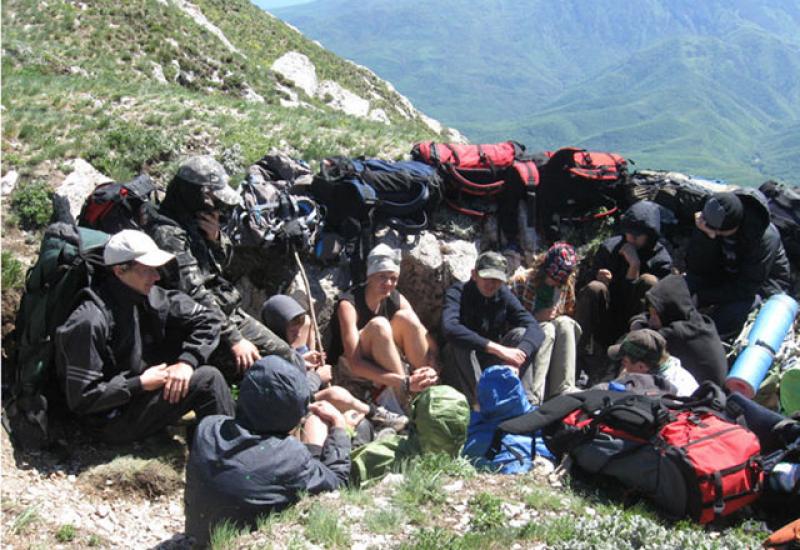Students During the May holidays the KPI students attending the tourism section joined forces with the pupils of the School #2 of Vyshniovka to go on a hiking trip of the first category of difficulty through the caves of Crimea. In the conditions of the hiking trip they practised, mastered and perfected their acquired theoretical knowledge: polished their skills of cross-country hiking, packing rucksacks, putting up tents, spending the night outdoors, making a fire etc. The students got acquainted with historical and cultural sites of Crimea, visited the Bakhchisaray Palace, the Uspensky and Shuldan cave monasteries, the cave towns of Chufut-Kale and Eski-Kermen, the Red Caves etc. Their route also passed through the picturesque trails of the Crimea Grand Canyon and the reserved mountainous massif of Chatyr-Dag. The tourists also climbed a few peaks, namely Angar-Burun (1453 metres high), Eklizi-Burun (1527 metres high) etc. Throughout practically the entire trip the tourists were accompanied by the wonderful sunny weather during the day and enjoyed the opportunity to admire the starry sky all night long. Only once, at the picturesque Taraktan trail near Yalta, they were caught in a thunderstorm with hail. In order to protect the wanderers from injuries, the trip leaders, lecturers of the tourism section V.A. Kuzmenko and V.M. Mykhailenko, allowed descending by local transport. The atmosphere of the trip was cheerful and emotional. Despite being tired and carrying heavy rucksacks, all the participants reached the end of their route (which means about 130 km of cross-country hiking) in good humour, having gained priceless practical experience, improved their physical condition, received a boost of energy and lots of positive impressions. For the next time the lecturers of the tourism section are planning a trip to the picturesque Carpathian Mountains which is going to include climbing Ukraine's highest peaks and visiting unique corners of nature. V.M. Mykhailenko, lecturer of the Department of Physical Training
Staff
A group of staff members of the Faculty of Management and Marketing and the Institute of Mechanical Engineering also went on a traditional trip through Crimea during the May holidays. They found quite a few ways of entertaining themselves, such as excursions focused on the history of the region, hiking trips, relaxing outdoors and trying local cuisine. Among other things, the polytechnicians discovered for themselves the little known remnants of a human settlement on the White Rock (Aq Qaya), which is believed to be the first capital of Scythia and is age-dated to the 4th or 3rd century B.C. The area of the fortification takes up nearly 10 ha and is surrounded by a 5 metres' wide wall from the northern side and by impregnable rocks from the southern side. The inhabitants engaged in cattle-breeding, there was also a trade route passing through the area. The foundations have now been dug out, the caves and a grotto with moss-covered walls have been opened, etc. The volcanic plateau Kara Dag is a unique and unmatched place in terms of flora and fauna as well as climatic and energy conditions. Up to 10,000 species of insects and more than a thousand inhabitants of the sea depths can be found there. The hiking trip around Kara-Dag with its incredible relief and legends was followed by a walk to the seashore, which included admiring bays and a fancy rock called Golden Gates. The rock is a signature tourist site of the Eastern Crimea, and, like a chameleon, it changes its appearance depending on the angle of view and the lighting. The cape of Meganom was another highlight of the trip. No one ever lived at this desolate terrain of 20 km2. The ancient Greeks believed that Styx, the river by which the souls of the dead travelled, flowed here. Nowadays, a few wind power devices have been installed here, which makes the landscape look a bit extraterrestrial. The polytechnicians also visited the lion park "Taigan", where they watched lions, including the albino ones, in their natural habitat, and were touched by the sight of young animals, especially one little giraffe, whom they fed from hands. Then they went on to see the park "Aivazovske" in Partenit, which attracts connoisseurs of the fine art of creating landscapes. The 200-year-old forest of olive trees is the heart of a composition in the antique style, the Raievsky rotunda has a breathtaking view of the bay and the park, and sculptures along with the waterfall basin recreate the style of Art Nouveau. As for the museum of stones of Oleksandr Kulish, no one had even heard of it before the trip. The visitors were shown the splits of stones and minerals (there were several thousand of them, of various forms and sizes, brought there from the whole world), fancy patterns on which resemble actual pictures. The interlacing of colours and lines is absolutely fascinating. The trip was, as usual, very exciting and well-organised thanks to the responsible attitude of Vitalii Kazantsev, an employee of the tourist agency of Sudak, and Alla Viacheslavivna Maiarchuk, metholodist of FMM. N. Vdovenko

